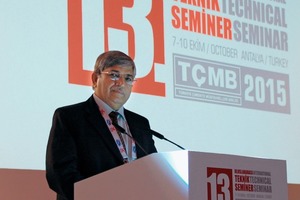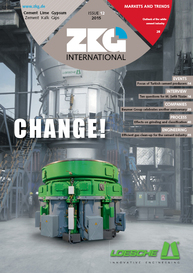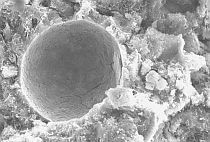The Indian cement sector – technological status and prospects
The Indian Cement Industry continues to be the second largest producer in the world, with installed capacity of around 390 million t and annual production of 270 million t in 2014-15. Future investment plans and policies of the Govt. of India indicate a continued rise in cement requirement over the years.
1 Overview
To meet the Govt. plans on development of highways, smart cities, affordable housing and other infrastructure, the projected demand for cement in 2019–2020 is 415 million t, implying installed capacity of at least 460 million t at 90 % utilization. The Indian cement industry is expected to continue its fast-paced growth and attain installed capacity of 850 million t/a by 2030 and 1350 million t/a by 2050.
The Indian cement industry has made tremendous strides in technological upgradation and assimilation of latest technology. Presently, about 99 % of the total capacity in the industry is based on modern and environmentally-friendly dry process technology. Continuous modernization and technology upgradation with state-of-the-art technology is being pursued by the Indian cement industry to achieve improved energy, environment and quality standards.
Single production line capacity of over 12 000 t/d with multi-stream preheaters and calciners; average thermal energy consumption of 726 kcal/kg (3037 GJ/t) clinker or average electrical energy consumption of 78 kWh/t of cement as at present were unimaginable two decades ago when these figures hovered around 3000 t/d, 880 kcal/kg (3682 GJ/t) clinker and 120 kWh/t of cement respectively. The best levels of thermal and electrical energy consumption achieved by the industry, namely 686 kcal/kg (2870 GJ/t) clinker and 68 kWh/t cement are comparable with the best in the world. Presently, cement companies in India are building global capacities, modernizing plants, improving efficiencies, cutting costs and restructuring their business houses to become highly competitive.
The technical innovations and constant modernization in mills, separators, calciners, burners, coolers, fans and air pollution control equipment have been chiefly responsible for such a phenomenal increase in capacity of single production lines as well as reduction in energy consumption and particulate emissions. The guide norms for cement plant operations developed by the NCB have also helped the industry in India to set up benchmarks for effective monitoring and improvement of operational efficiency.
2 Operating Costs
Operating costs have been inflationary over the last decade. Energy related costs – coal, power and freight constitute nearly 55–60 % of industry’s operating costs. In this scenario, cogeneration of power, a relatively recent initiative in the Indian cement industry, is expected to find wider application across the industry in future. 15 cement plants have successfully implemented it and have installed 200 MW of cogeneration capacity. The industry potential of co-generated power is estimated to be more than 600 MW. The Indian cement industry is also setting up power generation units using renewable forms of energy like solar and wind energy.
The Indian cement industry has shown phenomenal performance in terms of environmental protection. Plants have adopted various measures to reduce stack as well as fugitive particulate emissions. The Indian cement industry is also highly eco-friendly. More than 17 million trees have been planted in the last decade, which could act as a carbon sink. Abandoned mines have been turned into water reservoirs, with rain water harvesting and recreation sites.
The National Council for Cement and Building Materials (NCB) is an apex body working under the administrative control of the Department of Industrial Policy & Promotion, Ministry of Commerce and Industry, Government of India and is devoted to research, technology development, absorption, transfer, continuing education and industrial services for cement, building materials, concrete and construction industries. Research and development for widening of raw materials base, utilization of waste materials, improving the performance of cement and concrete and for greater sustainability of cement and concrete sectors constitute its core area of activity. NCB also provides consultancy services to cement and construction industries in various areas including geology & mining, alternative fuels & raw materials, environment, plant engineering and operation, energy conversation, trouble shooting, concrete technology and quality assurance in construction. The Council has so far completed 4189 projects out of which 3319 were industry sponsored projects and 870 are R&D projects.
3 Training courses
NCB conducts different types of training courses including a Post Graduate Diploma in cement technology, short-term courses on cement, concrete and construction technology and simulator-based training courses for cement plant operation. NCB has so far organized 2344 training courses and trained about 39 000 personnel from cement and construction industries not only from India, but also from African countries, Gulf countries, countries of the Indian Sub-continent and other regions of the world. NCB also provides testing and calibration services to cement and construction industries in India as well as in neighbouring countries. NCB developed certified reference materials quoted for Application in the Indian standard specification and also exported to various countries including UAE, Saudi Arabia, Ethiopia, Turkey, Australia, Oman etc.
4 Low Carbon Technology Roadmap
for the Indian cement industry
The Indian cement industry has already achieved a significant reduction in total CO2 emissions to an industrial average of 0.72 t CO2/t cement from a substantially higher level of 1.12 t CO2/t cement in 1996. CO2 emissions are targeted to be further reduced to 0.58 t CO2/t of cement by 2050. NCB has been actively associated with Indian industry members of the Global Cement Sustainability Initiative (CSI), a part of the World Business Council of Sustainable development (WBCSD) on a key project to assess opportunities for carbon emission reduction and increased resource efficiency in the cement manufacturing process in India. This has resulted in a Low Carbon Technology Roadmap for the Indian Cement Industry. Key levers to reduce emissions in the Indian cement industry are enhanced use of alternative fuel and raw materials, higher thermal and electrical energy efficiency, increased rates of blending leading to a reduction in clinker-to-cement ratio, widespread implementation of waste heat recovery (WHR) systems, and carbon use and CCS.
The National Mission for Enhanced Energy Efficiency (NMEEE) is an integrated approach for climate change mitigation through energy efficiency measures. The mission is based on market-based approaches to unlock energy efficiency opportunities. Perform Achieve and Trade (PAT) is one of the four components of NMEEE. The key goal of the PAT scheme is to mandate specific energy efficiency improvements for the most energy intensive industries, and further incentivize them to achieve better energy efficiency improvements. The scheme provides the option to industries, who achieve superior savings to receive energy saving certificates for the excess savings, and to trade the additional certified energy saving certificates with other designated consumers who can utilize these certificates to comply with their reduction targets. The Energy Savings Certificates (ESCerts) so issued will be tradable on special trading platforms being created in the power exchanges. The value of ESCerts would be market driven in order to make it attractive commercially.
The number of identified designated consumers for PAT Cycle-1 in the cement sector is 85 and the Energy Saving Target for the cement sector is 0.816 million t oil equivalent. Upon implementation of the first cycle of PAT, it is expected that India would save energy to the tune of approximately 6.70 million t of oil equivalent, worth US$ 11 million by the end of 2014–15, equivalent to a reduction of greenhouse gas emission by 24 million t/y.
5 Use of fly ash and other waste materials
60-70 % of cement production in India during the last few years has been in the form of blended cement using fly ash and granulated blast furnace slag resulting in the present average value of clinker to cement ratio of 0.77. The Indian cement industry consumes about 57 million t of fly ash with 28.5 % of the generated quantity, the entire quantity of granulated blast furnace slag generated which is more than 10 million t and 90 % of fluoro- and phosphor-gypsum waste from the fertilizer industry exceeding 3.5 million t.
The generation of fly ash in India is set to increase in coming years, and continuous innovative efforts are underway to enhance its utilization. R&D efforts at NCB and elsewhere have indicated the prospects of increased fly ash utilization through processing for controlling its size gradation and through chemical activation. Development of composite cements, high volume fly ash cement and fly ash-based geopolymeric cements, currently being pursued at NCB would also be helpful in enhancing fly ash and other industrial wastes utilization. With these developments the average value of clinker to cement ratio is likely to be further reduced to 0.73 in the year 2030.
The NCB has investigated the feasibility of using waste materials from different industries including refinery waste-E-cat, granulated steel slag, marble dust, jarosite and effluent solid filtration (ESF) cake as raw materials in cement manufacture and as blending components. NCB has also carried out studies on the suitability of lead-zinc slag, copper slag and other steel slags as raw materials and blending components for cement and established the feasibility. Joint efforts of NCB and Bureau of Indian Standards have resulted in development of standard specifications for the utilization of these wastes as blending components in cement.
There is tremendous scope for the utilization of various other types of wastes in the manufacture of cement, with benefits in terms of conservation of natural resources, and prevention of environmental hazards including mitigation of green house gas emissions, all of which serve the goal of sustainable development. In India, industrial and mineral wastes from mineral processing industries, such as metallurgy, petrochemicals, power, chemicals, paper and pulp account for more than 200 million t out of which more than 6 million t are hazardous. The utilization of hazardous combustible wastes is steadily gaining momentum. The perseverance of the Indian cement industry resulted in the successful trials on co-processing of hazardous combustible wastes in cement kilns, such as refinery sludge, waste oils, paint sludge, ETP sludge, spent wash etc. The industry is working to achieve international best practices of AFR utilization and it is expected that co-processing will soon become common practice in the Indian cement industry.
6 Sustainable development
The Indian cement companies conduct their business in an economically, socially and environmentally sustainable manner. The cement companies are following the Corporate Social Responsibility (CSR) practices in the field of heath & family welfare program, community infrastructure development projects, contribution to social programs, promotion of cultural heritage, natural resource management, women empowerment program, educational program, community welfare activities, etc.
Sustainable development in the construction field calls for reduced consumption of concrete in construction through innovative architecture and smart structural designs, reduced consumption of cement in concrete through efficient use of chemical and mineral admixtures and optimum size and grading of aggregates. There is an increased emphasis on using green building constructions using processes and materials that are environment friendly and resource efficient throughout the structure’s life cycle. At the same time R&D efforts are directed towards developing and adopting methods for designing buildings and concrete structures for a specified service life, use of C&D wastes in construction and replacement of natural sand by bottom ash.
Vigorous R&D efforts have been taken up, not only in the areas of resource conservation, energy and environmental management, waste utilization etc., but also in the focal areas like developing cements with lower clinker factors and geo-polymer-based cements.
While the world grapples with various issues of climate change, the Indian cement industry has set its sights firmly on sustainable development through the three-pronged strategy on “conserve, recycle and renew”; putting in tireless efforts to integrate sustainability issues, essentially in energy conservation, resource optimization and environmental planning.
//www.ncbindia.com" target="_blank" >www.ncbindia.com:www.ncbindia.com






